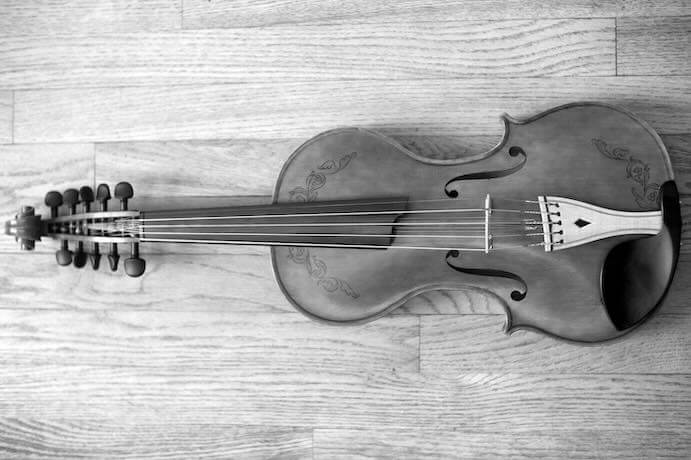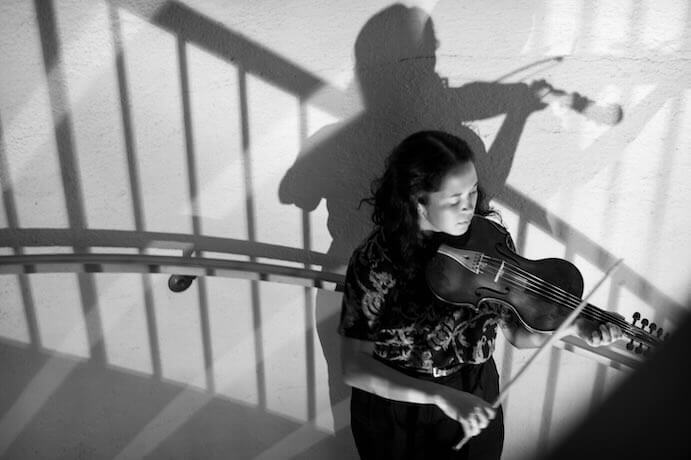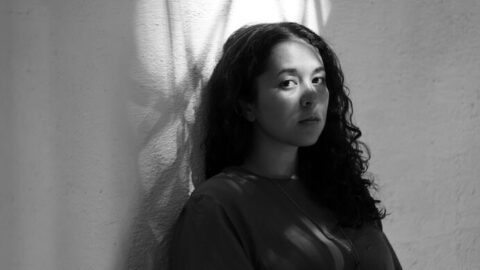Over the past decade, Zosha Warpeha’s work as a composer, performer, and improviser has traversed the relationship between experimentation and tradition. This might seem like an unlikely pairing, but as folklorist Dorothy Noyes notes, traditions are never static – instead, they create a crucial vehicle for communicating ideas about the past and present within communities.
A graduate of The New School’s Jazz and Contemporary Music program, Warpeha’s work as a violinist and vocalist has continued traditions of experimentation. But a parallel throughline in her career is a deep interest and sensitivity to traditional Nordic folk music. In 2019, she received a Fulbright to Norway to study hardingfele, an instrument with resonant sympathetic strings that accompanies traditional folk dances. In Warpeha’s hands, the instrument becomes a vehicle to connect with folk and experimental communities who value its unique sound.
Warpeha’s debut solo album, silver dawn (Relative Pitch Records), builds on this extensive body of work through 13 intimate tracks that showcase her unique approach to improvisation and the Hardanger d’amore (a similar instrument to the hardingfele). The opening tune, “wakerobin,” develops gestural ornamental figures into expansive meditative soundscapes. Tracks like “first light” amplify subtle details like bows scraping or fingers pressing into the fretboard, creating soundworlds similar to composers like Anna Thorsvaldsottir. Warpeha also leans into tradition through plaintive folk melodies in “johannea,” and adding haunting vocalizations in final track, “all nearness pauses.” As a whole, the album presents a breathtaking series of dialogues between Warpeha and her instrument; tradition and experimentation; community and place.
We caught up with Warpeha ahead of the May 3 album release to ask her about this latest project and the long arc of her creative research.
How did you originally become interested in hardingfele tradition, and the Hardanger d’amore you play on silver dawn?
I vividly remember the first time that I heard the playing of Nils Økland, a contemporary Hardanger fiddler. One of his early solo records, Bris, revealed to me a spacious world of listening and transience, sympathetic vibrations lingering during each breath. It was exactly what I had been searching for – I was in my undergraduate studies in jazz violin and was feeling out of place in a world that seemed to value virtuosity more than space and sensitivity. Soon after, I had a chance to try a Hardanger d’amore made by Salve Håkedal (the main difference from a Hardanger fiddle being a larger body with five bowed strings and five sympathetic strings, rather than four bowed and four or five sympathetic). I played a few notes and immediately felt so connected, like it was a natural extension of my voice.
I found myself a similar instrument by a luthier in Minnesota, but it took me a couple years before I dove into the tradition itself. I started experimenting with the instrument, composing for fiddle and voice and bringing it into free improvisation settings. I soon felt an urge to go deeper into my creative practice, to pay respect to the history and lineage of the hardingfele; this brought me to Norway for two years to study the tradition and develop my solo practice. These days, I perform on a Hardanger d’amore built by Salve Håkedal – the original model that I fell in love with – as well as a similar five+five fiddle built by Paul Wilson.

Can you tell us a little bit about the research you completed on your Fulbright in Norway, and how it informed your current practices and collaborations?
My Fulbright research in Norway was two-fold; it was an immersion in Norwegian folk music and an exploration of my compositional voice through the Hardanger fiddle. I studied at the Norwegian Academy of Music in Oslo, where I had the opportunity to learn from masters of the folk tradition – Håkon Høgemo, Anne Hytta, Unni Løvlid, among so many others. I learned tune after tune by ear on a traditional hardingfele, mirroring my teachers. I also immersed myself in the traditional dance community, learning all that I could about rhythm and form through my body, eventually playing for dances as well.
I didn’t really realize the depth of my own development as it was happening. The traditional studies felt, in a way, quite separate from my artistic work. But in my second year, I sat down on stage for an improvised process concert, and in a meditative state, everything started flowing out, uncontrolled. My feet started moving, tapping rhythms as though I was playing for dance, yet the beat wasn’t metric; it was like a heartbeat, slowly pulsing beneath the cyclical movements of the bow.
In later reflections, I found an explanation for this unconscious development in writings on embodied phenomenology. Knowledge belongs to the body, and in turn, the body knows how to act. By absorbing so much through aural learning, by physically experiencing the tradition, I built a tacit knowledge of traditional elements that goes much deeper than my conscious understanding. The memories in my hands and body now act as a guide for my improvisations, both in my solo practice and collaborative projects.
How did you balance the relationship between tradition and innovation in your improvisations that form the foundation for silver dawn?
I think that the balance naturally comes from the learning process that I engaged in; embodying the tradition through aural learning, building somatic knowledge. Instead of using these physical memories to construct traditional forms, however, I use them as building blocks – deconstructing idiomatic techniques, re-contextualizing and magnifying through repetition. For the improvisations that make up silver dawn, I chose three tunings that are found in the hardingfele tradition, which I know as: gorrlaus (F-D-A-E), klokkestille (A-D-F#-E), and fantestille (F-C-A-E) – depending on the regional tradition, these tunings can have different names. This approach grounds me in certain modalities, but using multiple tunings also lets me experiment with physical gestures. What happens if I play a familiar shape, but the interval between strings has changed?

What is perhaps more challenging than balancing tradition and innovation in my music is finding a balance in how I portray myself as an artist and build an audience. There are so many expectations implicit in the labels of “experimental” and “traditional” music, and I’ve experienced pushback from either side of the spectrum. Or in some cases, a presenter might be very quick to fixate on the instrument and promote a performance as Nordic folk music – but, it’s not. It may be inspired by tradition, but I am not on stage representing the current state of Nordic folk music.
Then again… maybe I am, and maybe I have a role to play as a practitioner of traditional music. In thinking about tradition and innovation, I always come back to this quote from Morton Levy, reflecting on the Hardanger fiddle tradition:
The slått [“tune”] has become a vibrating, shimmering field, which in the performance of each single player acquires ever new contours, new details, new expressions … The slått is no longer a piece of music but a system and a composition practice developed through centuries, giving birth to ever fresh entities.
I truly believe that traditional music requires innovation in order to thrive, to continue evolving and reflecting complex identities and communities in the current day. At any point in time, a musical tradition is the sum of its parts, of all players that are engaging with it in some way. If we try to capture a tradition exactly as it was fifty, a hundred years ago, it ceases to exist as a living, breathing organism.
In the album liner notes, you describe the importance of place and community in Norwegian traditional music. How do you incorporate these ideas into your creative practice, and how do they show up on the album?
I’ve always been inspired by the tradition of lydarslåttar, or listening tunes, in Norwegian folk music. These freely flowing tunes are impressionistic tone-paintings, often reflecting the natural world, stories, and folklore. My own approach to tone-painting is a bit more abstract – magnifying moments of time, textural or architectural details of a space, sensations of motion and rest. But there’s also a narrative arc to some pieces, a nostalgia connected to place and memory. The most magical and visual moments actually come when my mind is at its most meditative and clear – it’s as if the stillness allows me to channel my experiences of the world around me. When I listen back to the album, I hear such distinct imagery, even if I wasn’t conscious of it in the moment.
I feel strongly about the importance of communal listening experiences – of sharing a space with other people, experiencing time in a different way, breathing together. After a recent solo performance of mine, a friend shared that her heart would start beating faster as tension built in the music. I thought, how amazing is it that an entire room of people could be feeling a similar sensation, together? That thirty hearts might be beginning to beat faster, that blood is flowing more rapidly through all of these bodies at once? The empathy that’s created, the understanding that one has for a fellow audience member at the end of a performance, is really beautiful to me.
How do you hope to cultivate your creative work? What directions, collaborations, or projects do you hope to undertake next?
Oh, there are so many things I want to do! Now that my solo project is out in the world, the next logical step for me is to lean into collaborative work. I have a handful of duo projects that I have been cultivating over the last year, including collaborations with percussionist Carlo Costa, winds player Craig Schenker, bassist Tristan Kasten-Krause, and guitarist / instrument-maker Webb Crawford. I’d also like to engage in more multi-disciplinary work; last year I had an opportunity to live-score a full-length performance for four dancers, choreographed by Erin Landers, and I love how physical movement and visual space interacts with and inspires my compositional ideas.
In my solo work, I want to dig deeper into explorations of instrumental resonance and intonation in acoustically resonant spaces. Recently, I attended a residency at The Anderson Center in Red Wing, Minnesota, where I was able to explore different resonant spaces on the property, tuning my instrument and voice to reflect the tonal properties of each space. A few years ago, I was able to perform in the Emanuel Vigeland Museum in Oslo, a space that has up to 12 seconds of reverberation. That type of work really excites me, and I hope to find more opportunities to bring audiences into those spaces.
I CARE IF YOU LISTEN is an editorially-independent program of the American Composers Forum, and is made possible thanks to generous donor and institutional support. Opinions expressed are solely those of the author and may not represent the views of ICIYL or ACF.
You can support the work of ICIYL with a tax-deductible gift to ACF. For more on ACF, visit the “At ACF” section or composersforum.org.
























